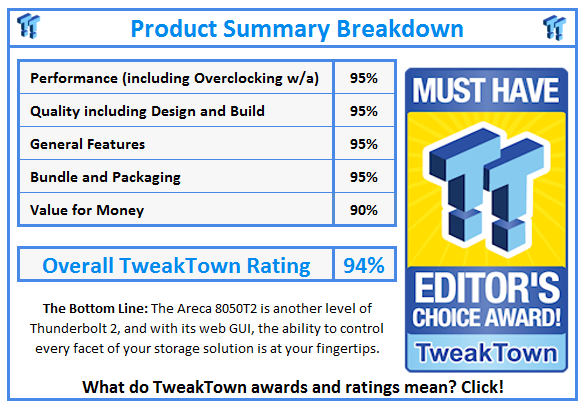Introduction & Pricing, Availability and Specifications

Over the past few months, we have enjoyed a tremendous amount of Thunderbolt and Thunderbolt 2 solutions coming through the lab. Until recently, the LaCie 5Big Thunderbolt we reviewed late last year was the most ambitious platform we have tested.
Today, things change quite a bit for myself, as we take things to an entirely new level of Thunderbolt storage with the Areca ARC-8050T2. The 8050T2 as we will call it from here on out, is a complete 6Gb/s SAS capable RAID storage solution, with compatibility on both Mac and Windows platforms. The 8050T2 utilizes a dual-core 800MHz RoC with 1GB of DDR3 memory and supports a hardware RAID 6 engine allowing for two drive failures without impacting data retention.
Another feature of the 8050T2 is its intelligent power function, which allows the RAID box to turn on and off with the host system to enhance data integrity. In addition to this, the Areca 8050T2 supports a backup battery option that protects all data in cache in the event of power loss.
Let's take a close look at it now.
Pricing, Availability and Specifications
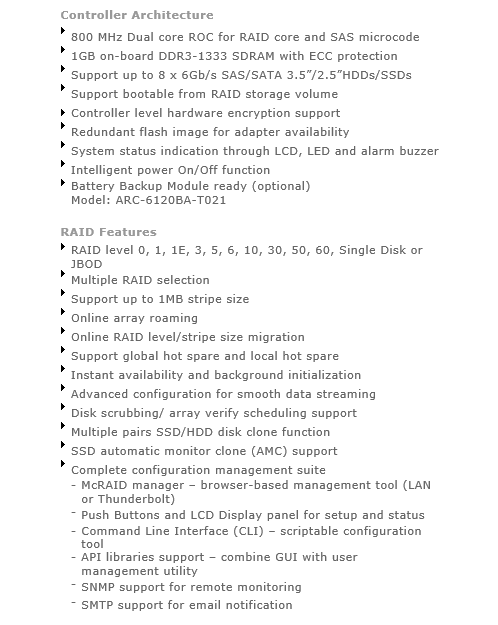
Above we have the simplified specifications for the ARC-8050T2. As you can see, the RAID box supports eight 6Gb/s SAS or SATA SSDs or HDDs, along with that it can be set as a bootable volume from Thunderbolt capable Macintosh computers.
RAID levels include 0, 1, 3, 5 and 6, along with higher levels 10, 30, 50 and 60. In addition, we have support for multiple RAID and stripe size up to 1MB.
MSRP for the Areca ARC-8050T2 is set at $1799.99 with a three-year warranty. Availability is high at this point with many online retailers having the unit in stock.
PRICING: You can find the Areca ARC-8050T2 DAS for sale below. The prices listed are valid at the time of writing but can change at any time. Click the link to see the very latest pricing for the best deal.
United States: The Areca ARC-8050T2 DAS retails for $1799 at Amazon.
Areca ARC-8050T2 Thunderbolt 2

Packaging for the 8050T2 carries an image of the RAID box on the front with the Thunderbolt logo displayed prominently in the center.

The top of the box details further specifications, along with a checklist of what is inside the box.

Here we have the scope of delivery; this includes reading materials, driver CD, along with a Thunderbolt cable, Ethernet cable and power cord.

Above we get our first look at the 8050T2. The unit carries an overall black aesthetic with silver drive trays. The center of the unit houses the two line LCD with buttons to control below it.

The back of the 8050T2 houses dual Thunderbolt 2 ports. In the center, we have the power supply and Ethernet below to the right.

Removing the outer shell of the RAID box, we get our first look inside. The power supply is mounted in the center with four bays flanking above and below.
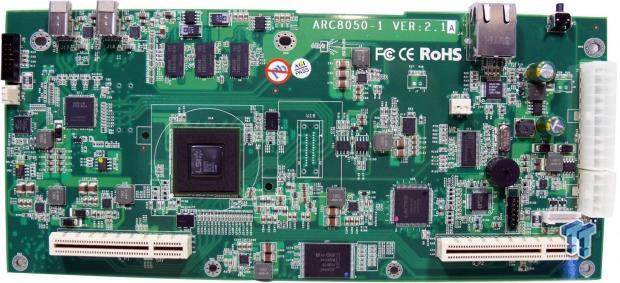
Here we have a look at the motherboard for the 8050T2. The bottom left and right hold the PCIe slots for the backplanes.
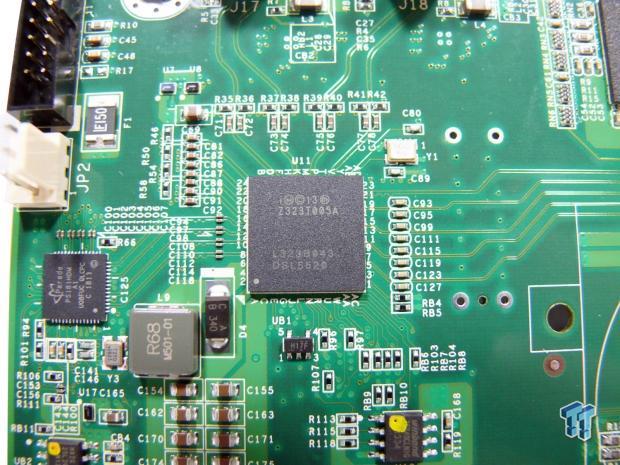
Here we have the Intel DSL5520 four-channel Thunderbolt controller.

Above, we have the LSI SAS2208 RoC with Samsung DRAM to the right.
Test System Setup and Web Management
Test System Setup
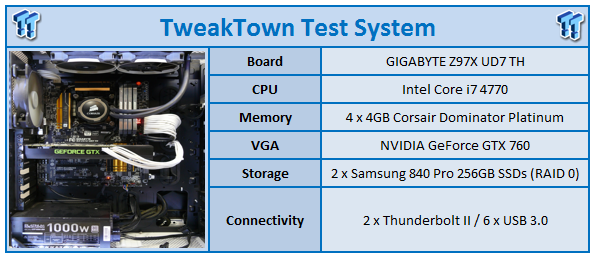
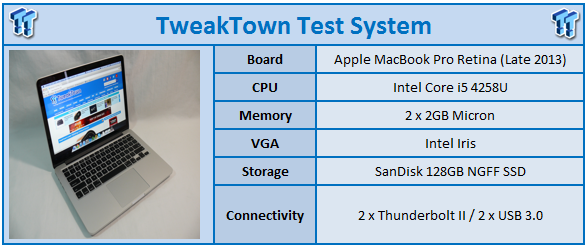

In testing the performance of Thunderbolt storage solutions, we utilize the Apple MacBook Pro Retina Late 2013 model, which as of this article is running OS X 10.9.1. Full system specifications are available above. To create RAID volumes in OS X I use Apple Disk Utility with 64K stripe size.
In addition to this, we use a Windows test system seen above for Thunderbolt appliances that support. Benchmarks used in Windows include IOMeter 1.1; all volumes use a 128K-stripe size and are tested without a file system.
AJA System Test

Check the performance of any drive on your system to ensure it is tuned for the performance you need.
Areca Web Management

Starting out with the web management GUI, we look at the system information tab. Here we can see the firmware information along with more detailed information about the RoC.

Next up we look at our RAID set hierarchy.

The hardware monitor tab, gives information about the temperatures inside the unit.

The ARC-8050T2 supports SNMP where you can setup then monitor your RAID tower remotely.

Next up we look at the Ethernet configuration, here you can setup the 8050T2 for remote access.

In the next menu, we have the RAID stagger power control.

The advanced configuration menu allows you to change TLER, along with optimize the Areca for streaming.

System configuration allows simpler setup options such as SATA NCQ and Disk Write Cache mode.

Here we have a mixed drive set in the Areca unit. Within the RAID set menu, you can create multiple arrays to suite your needs.
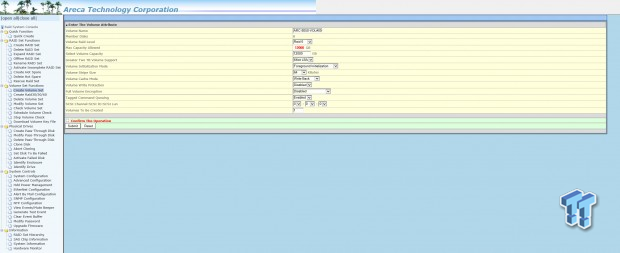
Here we have setup a 12TB RAID 6 array. Within this menu, you can setup multiple volume for each RAID set.
Benchmarks - 4K Random and 128K Sequential Workloads
Random and Sequential Workloads with HDDs
All testing below was done with eight WD Red 2TB drives.

Random read was rather impressive across all arrays. As you can see at QD32, we were able to reach 600 IOPS across the board.

Random write was quite good with RAID 0, while RAID 10 came in at 1160 IOPS at QD32.

RAID 0 and RAID 5 paved the way with sequential, reaching 719 MB/s and 722 MB/s, respectively.

RAID 0 again was the quickest array with sequential write, coming in at 702 MB/s.
Random and Sequential Workloads with SSDs
All testing below was done on eight SanDisk Extreme Pro 256GB SSDs.

Above, we have our very first test run with SSDs. As you can see, we maxed out Thunderbolt 2 at 63,284 random read IOPS.
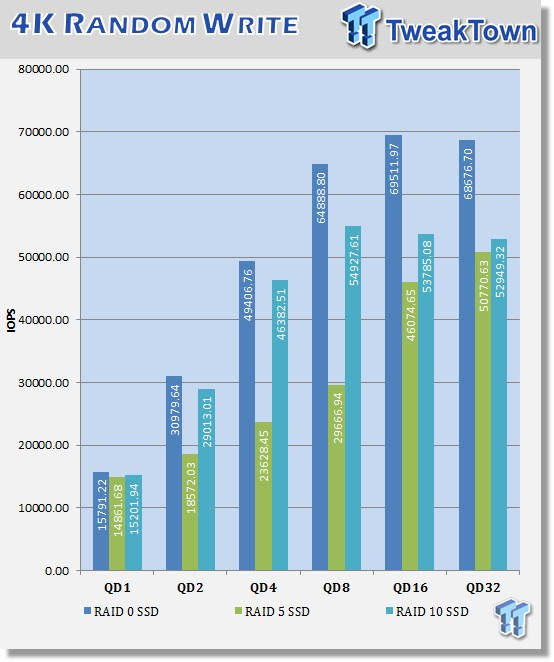
Random write IOPS came in at 69,511 at QD16.

Sequential read for the Areca came in at 1448.4 MB/s at QD32.

Sequential write came in at 1386.7 MB/s at QD32 with our RAID 0 array.
Benchmarks - Latency and Mixed Workloads
Page 5[Benchmarks - Latency and Mixed Workloads]
Latency

Random read latency was the best with the SSDs as expected, while the HDD arrays had RAID 10 as the quickest.

Random write had the RAID 0 array as the quickest.

Sequential read latency had the RAID 0 HDD array only 3ms behind the RAID 0 SSD array.
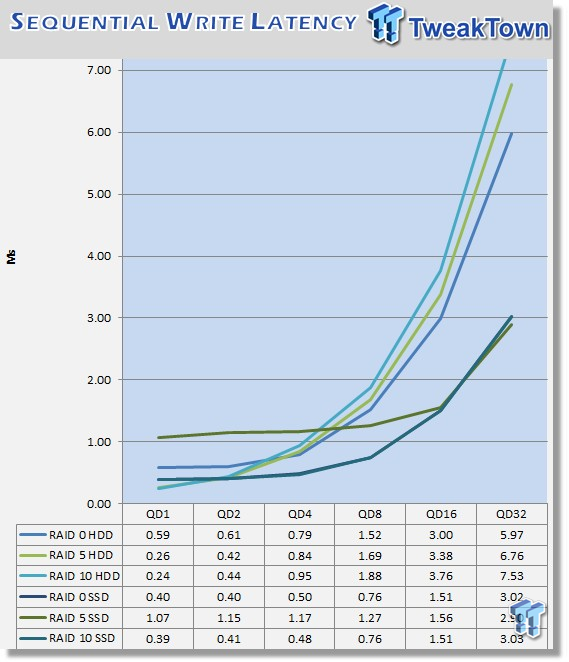
Sequential write had the RAID 5 SSD array as the quickest with the RAID 0 HDD taking honors on the other side.
Mixed Workloads

Here we have our first mixed workload, OLTP/Database. As you can see, the RAID 0 array excelled here at 475 IOPS.

File Server came in at 504 IOPS at QD32.

Email server furthered the performance at 434 IOPS at QD32.

Web Server had all RAID arrays matched in performance.

Once again, RAID 0 array did the best with Workstation
Benchmarks - AJA System Test
AJA System Test
All of the below benchmark were ran with our Apple MacBook Pro and OS X 10.9.4

In our 720p workload, the RAID 0 and 10 array showed steady read performance throughout, while the RAID 5 array showed some jitter.

720p write looked more like a heart rate machine than a benchmark result, as you can see performance was a bit erratic.

1080p read showed a peak of 1340 MB/s for RAID 0.

1080p write performance was once again all over the place. After testing, we found this to be a setting within the web config. We were able to clean up these tests by setting the number of streams to six.

4K read calmed the chart down quite a bit. At its peak, the RAID 0 array touched 1400 MB/s.

4K write had the RAID 0 array showing a lot of variability. This was cleaned up after testing by optimizing the number of streams to a value of six.
Final Thoughts

Our first impression of the Areca ARC-8050T2 was one of awe. For starters, this is the very first enterprise level Thunderbolt solution to come through the lab, and because of this, it enables you access to a completely separate tier of options in configuring your storage. With the Areca unit, you can utilize multiple RAID sets with multiple volumes, giving you the utmost in flexibility, while maintaining data integrity.
The performance of the 8050T2 was nothing but spectacular with our eight SanDisk Extreme Pro SSDs installed. These drives allowed us to take Thunderbolt to the extreme and peak out at a very impressive 1444 MB/s in RAID 0. With hard drives, performance suffered only sparingly and we were still able to reach 722 MB/s with our WD Red 2TB drives. Of course, with this unit able to utilize SAS HDDs, the options for storage capacity and performance are basically endless.
One feature of the 8050T2 I really enjoyed was the ability to boot my MacBook Pro Retina from the array, actually surpassing the storage performance of the built-in m.2 SSD by a fair margin, while having the ability to enjoy a literal tower of capacity. The only downfall I was able to source out on the Areca ARC-8050T2 was that the unit did not respond when trying to use an optical Thunderbolt cable, which I do assume is from the intelligent power function of the device, and as such lacks a power button.
Overall, the Areca ARC 8050T2 is a rather impressive Thunderbolt solution and being an Areca product has more options unlocked allowing top tier control of your storage.
PRICING: You can find the Areca ARC-8050T2 DAS for sale below. The prices listed are valid at the time of writing but can change at any time. Click the link to see the very latest pricing for the best deal.
United States: The Areca ARC-8050T2 DAS retails for $1799 at Amazon.


